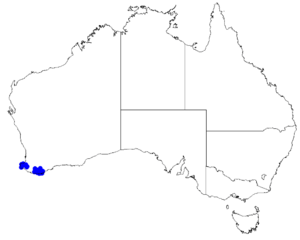Red boronia facts for kids
Quick facts for kids Red boronia |
|
|---|---|
 |
|
| Boronia heterophylla in the Australian National Botanic Gardens | |
| Scientific classification | |
 |
|
| Occurrence data from Australasian Virtual Herbarium | |
| Synonyms | |
Boronia heterophylla, often called red boronia or Kalgan boronia, is a special plant. It belongs to the citrus family called Rutaceae. This plant is endemic, which means it grows naturally only in the south-west part of Western Australia.
It's a tall, thin shrub with unique leaves that have three parts. Its beautiful flowers are deep pink to red and have four petals. These flowers grow one by one where the leaves meet the stem.
Contents
What Red Boronia Looks Like
Red boronia is a shrub that can grow from about 1 to 3 meters (3 to 10 feet) tall. It has thin, graceful branches.
Its leaves usually have three small leaflets, which is why they are called trifoliate (meaning "three-leaved"). Each leaflet is about 20 to 30 millimeters (about 1 inch) long. They grow on a stalk called a petiole, which is also about 20 to 30 millimeters long. Sometimes, the leaves might be simple, with just one part.
The flowers are a striking deep pink to red color. They hang down on a thin, bell-shaped stalk called a pedicel, which is about 10 millimeters (less than half an inch) long.
Each flower has four sepals, which are like small leaves that protect the bud. These sepals are round with a pointed tip and are about 2 to 3 millimeters long. The four main petals are about 8 millimeters (a third of an inch) long and feel a bit hairy on the inside.
Inside the flower, there are eight stamens, which are the parts that produce pollen. They are different lengths. The stamens closer to the sepals are black and don't produce pollen; they are about 1.2 millimeters long. The stamens closer to the petals do produce pollen but are smaller, only about 0.5 millimeters long. Red boronia usually flowers from September to November.
How Red Boronia Got Its Name
The scientific name Boronia heterophylla was first officially described in 1860 by a scientist named Ferdinand von Mueller. He published his description in a book called Fragmenta phytographiae Australiae.
The second part of its scientific name, heterophylla, comes from two ancient Greek words. "Heteros" (ἕτερος) means "different," and "phyllon" (φύλλον) means "leaf." This name was chosen because the plant's leaves can look a bit different from each other.
Where Red Boronia Grows
You can usually find red boronia growing near streams. It lives in the area between Busselton and Albany in Western Australia. It grows in several different natural areas, including the Esperance Plains, Jarrah Forest, Swan Coastal Plain, and Warren regions.
Is Red Boronia Protected?
The Government of Western Australia's Department of Parks and Wildlife has listed Boronia heterophylla as "not threatened." This means that, for now, there are enough of these plants in the wild, and they are not considered to be in danger of disappearing.

